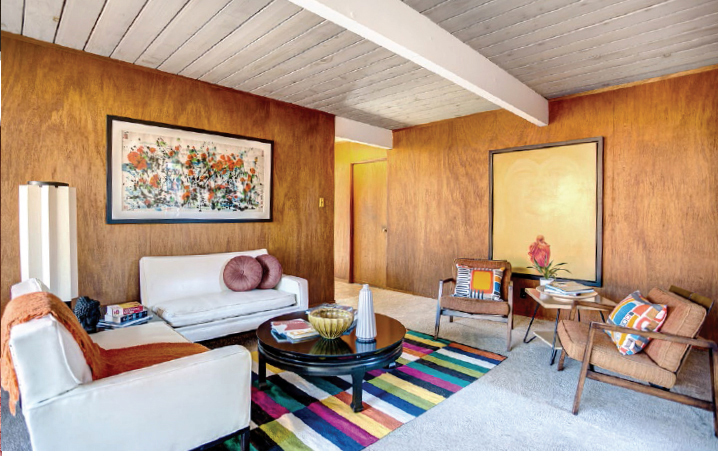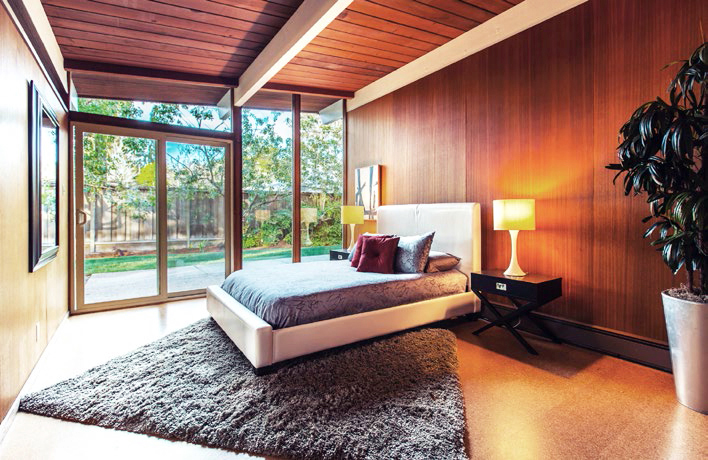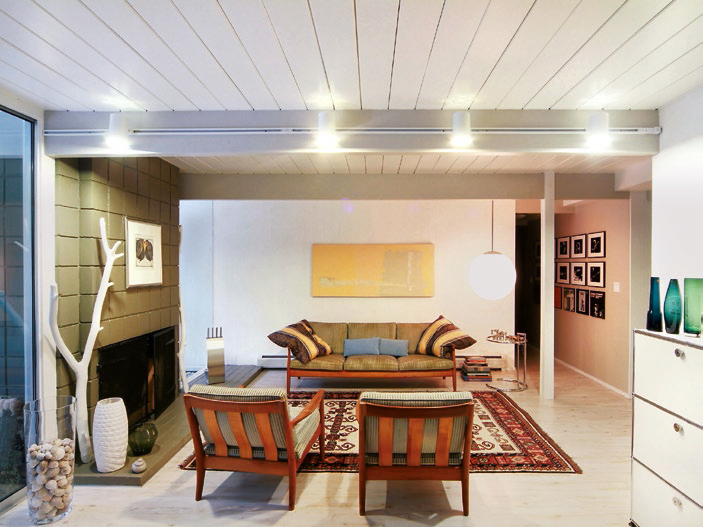Lauan's Lost Love - Page 2
 |
 |
|
|
 |
|
|
In Morepark, architects and newcomers Megan and Keith Blaine love their original paneling. The wooden panels, Megan says, are "an honest material instead of gyp [gypsum] and paint. Gyp and paint is a non-material."
It helps to understand the thinking behind Joe Eichler's decision to opt for wood-paneled walls versus painted stucco over lath and plaster or drywall. Being who he is, he could hardly have done it differently.
Eichler fell in love with modern architecture while living in a Frank Lloyd Wright house, the Bazett House of Hillsborough, with its walls of windows bringing light into a deeply comforting, wood-clad interior.
The first architects Eichler hired, Bob Anshen and Steve Allen, were influenced by Wright in his use of warm materials—besides wood, these included natural stone and brick—as were most California modern architects of the postwar era.
Many also traced their interest in natural materials and in homes that created contrasts of light and dark, openness and closure, to such Bay Area Arts & Crafts architects of the early 20th century as Bernard Maybeck, Ernest Coxhead, and Julia Morgan.
There was, in addition to that, the influence of the expressive wooden houses in Japan. A. Quincy Jones, whose firm Jones & Emmons was the second to sign on with Eichler, was particularly enthralled with Japanese design.
As the Los Angeles Times wrote in 1964 about a modern house by architect Sim Bruce Richards, "Given free rein, most California architects prefer to express themselves in wood."
The postwar era also saw a revived interest in wooden interiors and exteriors in residential architecture nationwide, not just in 'modern' homes but in ranchers and others as well. This was the era of knotty pine and the rumpus room.
"Recently, many designers have preferred interiors with wood-paneled walls—as abundant evidence in the housing field shows," William Merigold, an engineer with the timber firm Georgia Pacific, wrote in Progressive Architecture in 1953.
"On the West Coast," a 1955 ad for Weldwood Plankwell plywood boasted, "more than 60 percent of the buyers in a large development said wood paneling had helped them decide to buy."
It also turns out that plywood was something of a 'new' material right after the war, along with aluminum and plastics.
The excitement began building for plywood during the war, when Charles and Ray Eames were among modern designers who learned to shape the material into myriad forms. It was used for splints, in the Eames' case, and for wings for fighter planes.
Created by gluing together sheets of wood that were shaved from timbers in the form of broad ribbons, plywood gains strength over conventional lumber and resists warping. That's because each layer of wood is glued to the next at a 90-degree angle—so the grain of one layer points one way, the grain of the next layer the other.
"Plywood really did not gain wide acceptance as a building material until the hard-usage requirement of World War II demanded intrinsic improvement in this product that eventually raised its acceptance to unprecedented heights," Merigold wrote.




